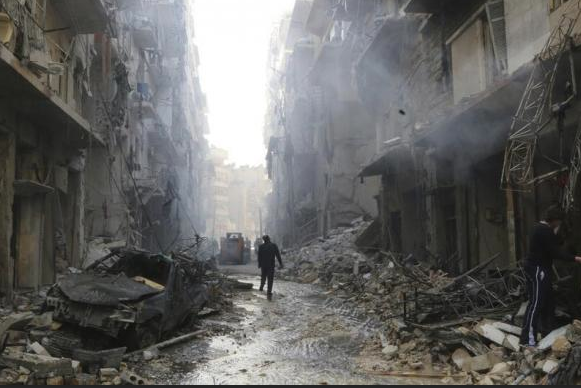It is understood that one of the challenges, and responsibilities, of photojournalism is to capture “the decisive moment”: that instant when intention becomes action or action becomes effect to define an event and perhaps change the course of history. This encounter with history’s eventfulness is not the only task facing either the photographer or the viewing public, however. To note another, perhaps equally daunting responsibility, we might ask how photography can represent history’s longer, more repetitive patterns. What happens when suffering is prolonged, destruction becomes routine, war is normalized, and searing images turn into genres of catastrophe?
This photograph from Aleppo is one answer to this predicament. It’s another scene from Rubble World, and images of wrecked urban neighborhoods in Syria have become so common that Reuters has gathered some of them into a slide show, which also helps the public face up to what is happening. We need to admit to the frequency and redundancy of these images. We need to grasp that war is now business as usual for too many people, and that no photograph is likely to change that.
So what can a photograph do? Perhaps it can show us how much is at stake, and how much already has been lost. It may have become too easy to see wrecked concrete as another occasion for urban renewal–hey, war is a job creator, come to think of it–or to see a broken city as merely a reason for pulling up the drawbridge–well, we don’t want that to happen here–or to accept the repetitiveness of the news as a reason to pay less attention rather than become more troubled. The photograph above challenges all of that and more.
Admittedly, this image has more aesthetic quality than some of the others in the series, but that is precisely why it is the more important political statement. The dark ruins on either side contrast with a stream of light flowing from the hazy shaft of space in the background to the muddy sheen of grey roadway in the foreground. It seems that one can move through this space, albeit slowly and carefully, but that there is no chance that one could live there. And so we get to the sole figure in the middle. He is walking through, and looking, perhaps in stunned amazement, perhaps with a specific curiosity, but slowly and carefully. What else can he do? What else can we do?
This emphasis on his nomadic movement and contemplative gaze is underscored by that fact that we see him as the silhouette of a human being. No more ascriptive marker is provided: you can’t limit his identity to Freedom Fighter or Aid Worker or Resident. Instead, he is much closer to a philosophical figure: the Existential Subject who, with his civilization in ruins and only empty space for a god, now has no choice but to consider how civilization and barbarism are two sides of the same thing. He could be that thing, the abstract human being that usually is clothed in this or that social identity, but now–like the city itself–has been stripped down to reveal how close it always was to desolation.
The war in Syria has gone on for four years. Add to that ten years and counting in Afghanistan, plus the “sectarian violence” (i.e., continuing warfare) in Iraq, the many wars periodically erupting across Africa, the drug wars in Latin America, . . . . If any of this is to stop, something more than another decisive moment is needed. The pressure for peace will have to be as it always has to be: slow and wide and insistent and then more insistent. If that is to become a decisive process, it will need habits of representation and spectatorship to match. Fortunately, some of what is needed is already available. The question remains, what, or who, is still missing?
Photograph by Hosam Katan/Reuters.

[…] Humanity Among the Ruins (No Caption Needed) Robert Hariman on what happens when suffering is prolonged, destruction becomes routine, war is normalized, and searing images turn into genres of catastrophe? […]
[…] Humanity Among the Ruins (No Caption Needed) Robert Hariman on what happens when suffering is prolonged, destruction becomes routine, war is normalized, and searing images turn into genres of catastrophe? […]